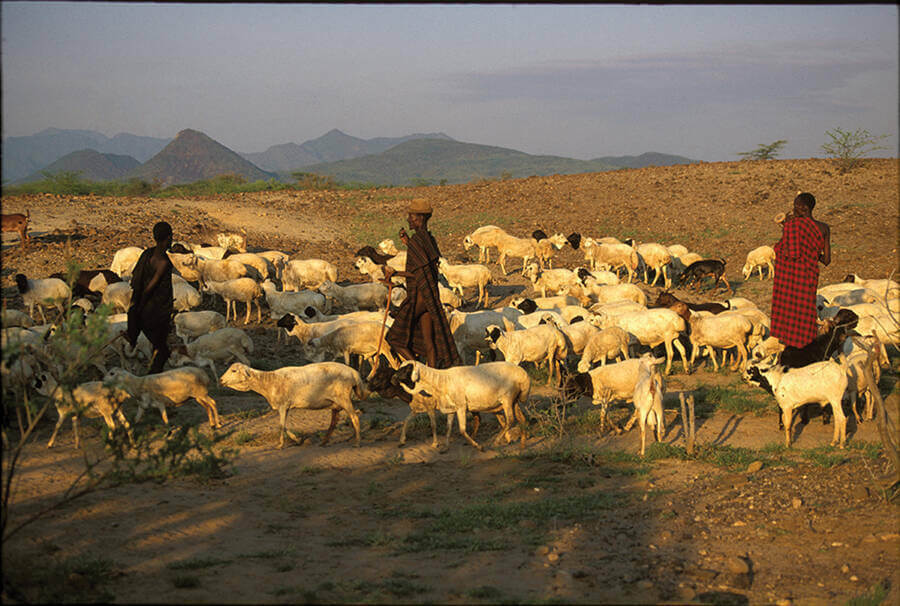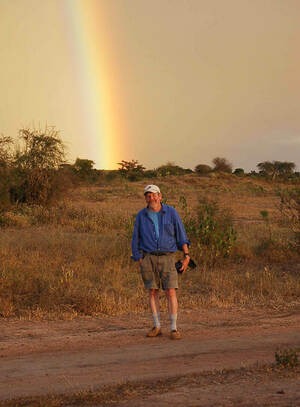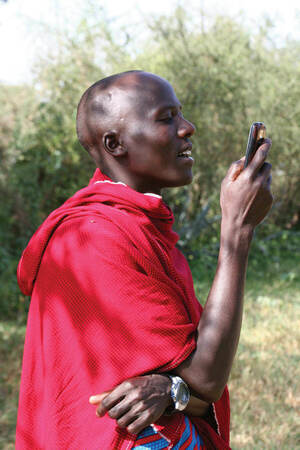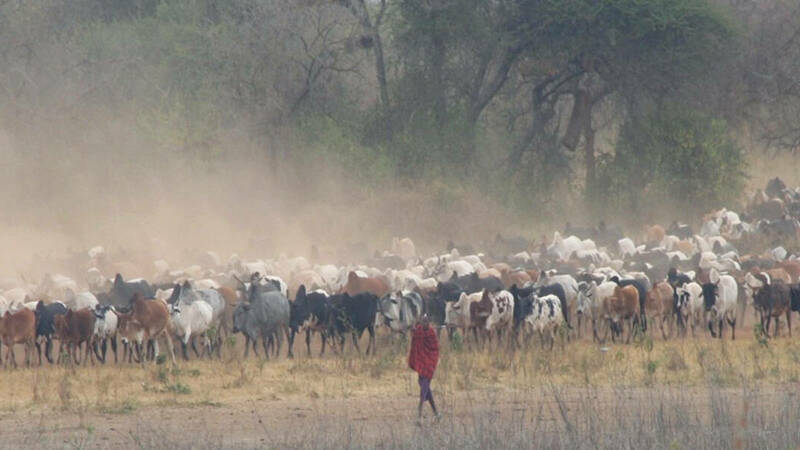Before venturing for the first time into the Turkana district of northwestern Kenya to study the land- and livestock-management practices of the region’s nomadic herders, J. Terrence McCabe ’70 picked up a newspaper in Nairobi. He saw an article about his destination under the headline, “A land where even the flies have fled.”
McCabe read about the hot, arid climate, the snakes, and the violent, intertribal raids endemic to the area where he was about to begin anthropological fieldwork. This was 1980, when he was a doctoral student at the State University of New York at Binghamton. From what little research existed on the Turkana people, he knew they were “famous for being very difficult to work with. And so that was a bit intimidating.”
Driving through the bush, McCabe saw no one, and nothing but sand and gravel plains stretching to distant mountains. He would have to find people out there somewhere and convince them to allow him into their lives for months at a time.
His parents had wanted him to be a dentist. As he traversed the desolate Kenyan landscape, a question his father had asked came to mind: “How are you going to do this?”
McCabe thought, I have no idea how I’m going to do this.
He spent the night in the town of Lokori amid the sound of gunfire. A skirmish between bandits and soldiers from the local army post prompted him to consider the irony of his circumstances: “I didn’t get caught up in Vietnam, but I seem to have gotten myself in the middle of a war here.”
McCabe was a bystander, but violence against an interloper would not have been unexpected. The Turkana have a single word, emoit, for both “stranger” and “enemy,” and they operate on the principle that “all enemies should be killed.”
As director of the Environment and Society Program at the University of Colorado, where he has taught since 1989, McCabe now makes his home in the Rocky Mountain college town of Boulder. But his research has revolved around years of fieldwork in Africa, first among the Turkana in Kenya and now with the Maasai in Tanzania. To overcome his status as an emoit, he took a narrow and deep research approach. Rather than attempting to survey a statistically representative sample of herders, he developed close relationships with four welcoming families over years of extended visits.
Beginning with his arrival in 1980, McCabe spent what added up to four years — in annual increments of about four months at a time — as a researcher with the South Turkana Ecosystem Project. He worked with other anthropologists and ecologists studying how the pastoral herders, among the most mobile in the world, adapted to unpredictable weather patterns and competed for limited natural resources. Most of all, McCabe spent time with the families whose experiences formed the basis of his award-winning 2004 book, Cattle Bring Us to Our Enemies.
A typical anthropological field study might last eight months to a year, but he felt he had only begun to break down barriers after that much time. “I think it took eight months of being there,” he says, “before anyone told me the truth.”
Even as he became a trusted presence among the four families who befriended him, others did not take McCabe into their confidence. He may not have been an emoit among the Turkana anymore, but neither was he an intimate to most. In order to draw accurate scientific conclusions he would have to upend customary research procedures.
“In regular methodology, the larger the sample, the less bias,” McCabe explains. “And in Turkana, it was exactly the opposite. I believed what the people in these four families said, and I couldn’t trust what anybody else said.”
McCabe studied how the families oriented themselves within their larger pastoral communities and around the raising of cattle and camels, goats and sheep. Natural resources, weather patterns, interpersonal alliances and tribal conflicts informed the choices family leaders made about where and when to move their herds.
He recalls one family’s decision to combine all its goats, bringing together herds the father had divided among his sons. Where they planned to merge the goats, ecologists pointed out, the trees had larger leaves — more food for the animals.
McCabe gleaned a more nuanced understanding of the significance of foliage size from a family discussion around the campfire. Larger leaves offered better sustenance and protection from the raiders and predators that could more easily cull herds that remained dispersed in the open.
The decision was made on a combination of those factors, “but it was the herders telling their father, ‘We need to move, otherwise we’ll lose some of these animals,’” he says.

External perceptions of the Turkana, McCabe writes, once depicted them “as people engaged in a primitive and outdated livelihood wandering around in a bleak landscape and irrationally keeping large numbers of livestock for prestige.” Experts on their way of life now understand them as proactive and creative decision-makers, agile in mind and body, adapting to difficult and dangerous conditions to preserve the resources they need to survive.
Their homeland has little agricultural potential and considerable political volatility. And as the world grapples with climate change in all its ecological and socioeconomic dimensions, McCabe notes the Turkana “have much to teach us about coping with these stresses, about survival and resilience.”
At the local level, deliberations about livestock movements can seem far removed from such global forces. Herd sizes, weather conditions and available labor play significant roles, as do family leaders’ temperaments and the influence of their multiple wives. Two herd owners McCabe came to know well — men named Angorat and Lorimet — were brothers-in-law but polar opposites in how they managed their animals.
Angorat moved his herds with aggressive frequency, often on the leading edge of the larger Turkana migration and before many family leaders were ready to shift locations. He also subdivided his animals more than most, relying with confidence on his brothers to handle the smaller herds entrusted to them.
Lorimet did not have the advantage of dependable relatives, and his disposition tended toward caution. While Angorat often blazed a trail for families moving their herds, Lorimet brought up the rear. Each approach had costs and benefits.
At the head of the pack, Angorat’s livestock enjoyed abundant resources. The tradeoff, especially as circumstances warranted moving toward tribal borders, was the risk of exposure to raiders. Those farther back had better protection from attacks.
Livestock raids were frequent in the years McCabe lived among the Turkana, the threat always casting a shadow. Unused water holes were scouted for footprints and other signs of lurking enemies. Attacks often occurred just before dawn, triggering vicious fighting that could leave many people dead. Just how many deaths is difficult to quantify, but likely many more than the infrequent news reports about such incidents indicated. An article in The Economist estimated that as many as 10,000 Turkana people were killed in cattle raids from 1991 to ’94.
Like all tribes in the region, the Turkana valorize their raiders. Scars on men’s shoulders enumerate the killing of enemies, and the livestock that rustlers accumulate and distribute among their families bring them great respect. As a group, the Turkana are known as “fierce warriors and deadly enemies,” though McCabe witnessed a period when the balance of power tilted against them and government forces provided arms and other forms of support for rival groups.
His book explores the multifaceted political, cultural, economic and ecological factors that drive violence among Kenyan pastoralists. The climate is unforgiving and resources are scarce, conditions that ignite seemingly inevitable conflict. Over time, McCabe argues, the emotional toll of the hostility becomes its own motivation to keep fighting. “One may be able to identify some underlying ecological or economic factors that help explain the perpetuation of raiding,” he writes, “but when members of another group kill those you love, the relationship becomes personal.”

Personal relationships of a more fruitful kind made McCabe’s research among the Turkana possible. Not to the exclusion of more objective measures, but without the inside knowledge drawn from frequent and meaningful contact, his work might have felt incomplete. Instead, Cattle Bring Us to Our Enemies received the Julian Steward Award from the American Anthropological Association. In the Journal of Modern African Studies, Cambridge University’s William Adams described it as “a book rich in data, but also rich in insights into people as individuals,” praising McCabe’s contribution to the discussion of balancing social and ecological research.
“There’s really no substitute for getting to know the people you’re working with really well,” McCabe says, “and you really need to have both a qualitative and quantitative component to the research you’re doing.”
How’s this for both qualitative and quantitative? During his time with the Turkana families, two newborns were named for him. One such honor came after he drove herd owner Lopericho’s wife, Lodio, to the hospital during a difficult pregnancy. As the story goes, after the birth of a healthy daughter, Lodio and Lopericho deliberated between the name of the anthropologist and his car. Rather than calling her Suzuki, they chose Terry.
Those close bonds, as valuable as they were to McCabe’s work, created some fraught situations when it came to conducting disinterested scholarship. His participation in their activities had ethical limits — and gray areas.
McCabe and his colleagues would help with routine activities like butchering animals, but they refused to get involved in the fighting that occurred during raids. They would not arm themselves because the impulse to help their host families would be too great, possibly leading them to injure or kill someone.
McCabe’s quick to add that sitting out the tribal battles wasn’t an entirely humanitarian choice. “We’d probably just get slaughtered,” he says, “because the people that we would be fighting are people who have fought in the desert their entire life.”
As he moved among families, McCabe would pick up information that might be valuable to his friends. Out of professional obligation, he would not share anything that might influence the decisions he was there to study. Someone might ask about the best grass he’d seen in his travels around the region, but he would not say. If a family moved its livestock there on his advice, it would skew his research.
“Sometimes,” McCabe says, “I would estimate that I’d say ‘no’ more than 200 times before 4 o’clock in the morning.”
Other times he felt compelled to intervene. When a disease threatened a goat herd, McCabe agreed to transport one leader to a place where Somali traders had the tetracycline that would cure the illness. “If I wasn’t there, one of those goats would have died. And considering I was also paying attention to stock mortality, I knew what I was doing was going to influence that,” he says. “But in that case, I have to help to the extent that I can.”
His primary mission as a researcher is not to help, but to understand. To record and analyze a way of life, and to elucidate its lessons. His fascination with understanding the people and cultures that became the focus of his life’s work started early. Watching African wildlife shows as a boy, McCabe would tell his mother, “When I grow up, I want to work there.”
Two weeks after graduating from Notre Dame in 1970, he was in Sierra Leone with the Peace Corps. Living in an isolated village 70 miles from the nearest fellow expat, he endured two grueling years cultivating rice.
Of his initial group of about 20 volunteers, only two stayed the whole time. Risk of disease weeded out foreigners in a land the British had called “the white man’s grave” during the colonial period that had ended less than a decade earlier. The physical toll was evident at the end of McCabe’s stint.
“I think I weighed 98 pounds, and I had to carry around a piece of paper that had like a hundred different things on it,” he says. “‘If this person is found unconscious, please consider he may have been exposed to the following. . . .’”
He was not dissuaded from returning. Rather than West Africa’s tropical rainforest, though, he preferred the savannas across the continent, which led him as a graduate student to a remote Kenyan region with its own perils — some he read about in the Nairobi newspaper, others he did not. That article did not report, for example, that scorpion stings were a risk of sleeping on the ground. They got him twice. A cot didn’t provide enough protection because, as McCabe puts it, “the hyenas would eat your face.” So he slept atop the roof of his truck on a mattress he unrolled across plywood.
Though he relishes telling such stories — echoes of his childhood enthusiasm still reverberate — he takes pains to avoid creating a caricature of the communities he’s encountered. “From the outside, it looks like I’m working with a bunch of really exotic people” who have little in common with him, he says. “In fact, everyone’s the same.”
Years ago, McCabe recalls, he moved his elderly mother to Boulder, where he and his wife and daughter could better care for her. Aging parents lived among the Turkana, too, creating similar complications for their adult children, who likewise had to tend to their own families and livelihoods. “They did a better job of it than I did,” McCabe says. “We all have the same issues. And I think it’s really important to realize that.”
Where older generations could subsist on raising livestock, younger people consider diversification essential to their survival.
McCabe focuses much of his current research on the Maasai people in Tanzania, who like the Turkana have built their way of life around herding cattle. One issue they face may sound familiar: phone calls from unknown numbers. A key difference is that, to the Maasai, the calls are not always an annoyance.
In a study published in June, McCabe and his colleagues found that significant numbers of “accidental friendships” have formed from these misdialed calls. These relationships have expanded Maasai social networks and spawned fruitful economic opportunities.
The analysis notes that high levels of illiteracy lead to people dialing and answering wrong numbers more often. And when batteries die in places without sufficient access to electricity, callers borrow phones and have to dial their contacts manually. “Mistakes are common,” the researchers write, “and people can be randomly connected across Tanzania and parts of Kenya.”
Mistaken cellphone calls have introduced people — who often face similar life problems — from groups that otherwise might never connect. An expanded circle of acquaintances becomes a source of support for ordinary and extraordinary needs. “Social networks are the key to being in this unpredictable place,” McCabe says, “and you want to have as many people that can help you when you need it.”

Accidental friends might share information that improves access to “materials, markets and money,” the researchers say. One Maasai man reported a misdialed phone call with a person in Dar es Salaam, the economic center of Tanzania. The conversation led to the topic of a rare medicinal plant the city dweller needed. After the call, the man began harvesting the plant for regular shipments to the city.
Others have rented their land to farmers after such calls. Still more share information about weather conditions and forage quality for people grazing their herds. During a severe drought, one man moved his livestock to a village with better resources.
“This was illegal,” McCabe’s study reports, “but the accidental friend he had made in that village pretended the animals were his own — and the herd survived where many didn’t.”
Cellphones, combined with for-hire transportation on small motorcycles called boda bodas, have even helped humans survive. Transporting a sick person from a rural area to a hospital in town once would have taken a couple days on a donkey. Now a boda boda might make the trip in minutes.
The most significant factor in the substantial changes McCabe has witnessed in Maasai society — which he has studied for more than three decades, overlapping for a time with his Turkana work and still ongoing — might not be technological at all, but mineral. Demand for tanzanite, the blue and violet gemstone discovered in 1967, introduced a market that has generated remarkable wealth for many who live otherwise traditional lives.
McCabe once saw a man wearing a customary red shuka blanket stop his motorcycle at a roadside stand to peruse some gems. The man pulled out a jeweler’s loupe, examined the tanzanite, made an offer and, after haggling with the salesman, McCabe says, “off he goes in a cloud of dust.”
Money from the tanzanite business inspired many Maasai to make changes in their lives and work that no amount of external pressure or persuasion could accomplish. For a century or more, Tanzania’s colonial and independent governments had urged people to adopt modern agricultural practices — to cultivate crops and give up their nomadic lives on the range. “Totally unsuccessful; couldn’t do it,” McCabe says. “And then, starting in the mid-1970s, 1980s, people just started settling down by themselves and adopting cultivation.”
Where older generations could subsist on raising livestock, younger people consider diversification essential to their survival. Many families now incorporate grain cultivation as a hedge against years when their animals do not thrive — and vice versa. “Now people go, ‘We want to be modern Tanzanians; modern Tanzanians grow maize,’” McCabe says. “So you’ve got this whole shift in how people perceive this. It used to be that was something they didn’t want to do at all. Now it’s part of normal life.”
Young men also go to cities for work as guards, another economic buffer against fickle nature and a break from the traditional, pastoral rites of passage. Much of Maasai life today appears to be a mashup of tradition and transformation. McCabe describes one boma — a family compound of huts made from mud and dung — where homes built in the time-honored manner stand next to a cinder block house that has an array of solar panels and a large television that attracts friends to watch big soccer games. “One of the people I know has a four-wheel-drive black Lexus,” he adds, “but they’re also just typical Maasai.”
Amid the changes, older people have reported to McCabe that they feel disrespected, their simpler way of life as herds-people dismissed. Their children and grandchildren, on the other hand, feel misunderstood by their elders for making necessary adaptations to an unpredictable climate, or for requiring better income to cover the rising costs of hospitals and schools.
“People are complicated,” McCabe says, and so are the economic, cultural and ecological forces that shape societies. Over four decades in Kenya and Tanzania, he has measured the impact of those forces on the Turkana and Maasai cultures, and been a witness to their human complications. Despite the evident differences between these two peoples, let alone from his own world back in Boulder, McCabe’s research keeps bringing him back to a qualitative conclusion.
Get to know people well enough, and “everyone’s the same.”
Jason Kelly is an associate editor of this magazine.
